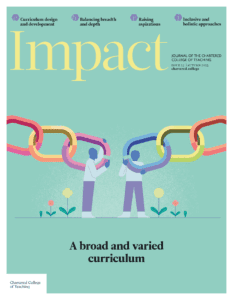Women and girls in a coherent curriculum

CHARLIE CUTLER, FORMER DIRECTOR OF CURRICULUM, UNITED LEARNING, UK
BETH WALKER, HEAD OF UNITED CURRICULUM OPERATIONS, UNITED LEARNING, UK
Whether a student is a girl or a boy will determine their experience of the education system and our society more broadly. It may influence their curriculum choice: the likelihood of a girl choosing to pursue a career in STEM (science, technology, engineering and mathematics) is far lower than that for her male peers (Government Equalities Office, 2023). While some of this disparity may reflect individual preference, recent findings from the Trends in International Mathematics and Science Study (Richardson et al., 2025) identified a concerning decline in girls’ achievement in mathematics and science. The early findings attribute this to factors such as confidence, a sense of belonging and absenteeism.
Across United Learning, we want to provide an education that enables the best in everyone, in which all students can make informed choices – free from bias or discrimination – and leave school with the knowledge and character required to succeed in their chosen future. A wide range of factors can influence these outcomes, many of which lie beyond the control of schools. However, as highlighted in the Department for Education’s recent interim report (DfEDepartment for Education - a ministerial department responsible for children’s services and education in England, 2025), the curriculum plays an important role in supporting student engagement and positive outcomes.
Over the last academic year, we have systemically reviewed our trust’s common curriculum. For each subject, a dedicated working group – comprising curriculum leads and subject experts from over 30 schools – collaborated to evaluate and refine content. Their work was quality-assured by a leadership panel made up of female primary and secondary headteachers and senior leaders, chaired by one of our regional directors. This process sparked meaningful discussion across schools and the final recommendations were agreed on by the CEO and education directors.
Drawing on the insights from this review and conversations that it generated, we have outlined six key areas for schools, trusts and contributors to the National Curriculum and Assessment Review to consider when evaluating the representation of women and girls.
1. Representing women in the implicit curriculum
The main starting point for many reviews of women in the curriculum is consideration of the incidental references to people, professions and perspectives across subjects, including the imagery to which students are exposed in lesson materials. These references, often added unconsciously, could be considered innocent in isolation but, over time, may reinforce stereotypes and sex-based expectations.
In English, students may rarely encounter texts written by women. In maths, questions involving professions or daily activities might reinforce sex-based expectations: builders are frequently male, while carers or teachers are often female. In geography, students may see photographs of secondary industries where all employees are male. When students consistently see men in scientific or industrial roles and women in domestic or service roles, restrictive norms are fortified. Students should encounter women in science, leadership, politics, the arts, sport and innovation. The girls in our classroom today should be aware of the wide range of opportunities available to them in their futures.
2. Meaningfully representing women’s voices and experiences
While addressing the implicit curriculum is a useful starting point, it is not sufficient. Schools should also ensure that women’s voices and experiences are valued and represented meaningfully. This requires sufficient time to explore the contexts of these voices and experiences, and cannot be achieved with tokenistic, passing references.
In history, Catherine of Aragon should be considered not solely as the wife of Henry VIII but as a political and religious figure in her own right. In religious studies, the inclusionAn approach where a school aims to ensure that all children are educated together, with support for those who require it to access the full curriculum and contribute to and participate in all aspects of school life of a female religious leader’s teaching on a specific topic should be included to challenge students’ thinking or deepen their understanding.
We need to consider the nature of the stories being told. A limiting narrative can be created if women are predominantly presented through the lens of struggle or victimhood. While it is important to study the effects of patriarchy and inequality, students should also encounter stories of female leadership, creativity and achievement. This balanced representation can help to cultivate ambition and confidence among girls, whilst broadening all students’ understanding of historical and contemporary realities.
It is also critical to reflect the diversityThe recognition of individual differences in terms of race, ethnicity, gender, sexual orientation, socio-economic status, physical ability, religious beliefs and other differences of women’s experiences. A curriculum that includes only white, middle-class women fails to represent the full spectrum of voices in society. We should be intentional in our efforts to include women of different ethnicities, faiths, social classes, sexual orientations and abilities.
3. Explicitly challenging stereotypes
We believe that the curriculum should teach students to recognise and challenge gender stereotypes explicitly. This means not only presenting positive role models but also teaching how stereotypes operate and the impact that they have.
For example, the PE curriculum should include the physiological differences between girls’ and boys’ bodies once they reach puberty, and that the subsequent move to single-sex sports classes is for reasons of safety and accessibility, and not skill. Any notion that girls are ‘less good’ at sport should be explicitly challenged in the curriculum.
4. Exploring society and culture
Challenging stereotypes requires more than representation or critical discussion; it requires students to understand the societal and cultural structures that produce and sustain those stereotypes. Subjects such as history, religious studies and geography offer opportunities to explore how norms and expectations have been shaped across time and place. Students should learn how the socio-economic context and legal rights of women have changed in Britain, how this varies across the world and the role that religious and philosophical teaching has played in the experience of women, past and present.
This content must be approached objectively and in line with the expectation of impartiality (DfE, 2022). Our goal is to give all students an accurate and balanced view of the world as it is, from which they should be taught to analyse evidence and consider multiple perspectives, and be supported to form their own informed views.
5. Maintaining curriculum integrity
We must ensure that when designing or reviewing our curriculum content, we hold the disciplinary purpose of each subject at the forefront. We should be confident that our changes will only enhance and deepen students’ understanding of the subject and its content.
Curriculum development should not include content that is tangential to or disconnected from the core discipline. In science, for example, lessons should not be reduced to biographical accounts of female scientists at the expense of conceptual depth. Instead, the curriculum can be strengthened by incorporating examples where gender is directly relevant to scientific understanding – for instance, the gendered impacts of particular health conditions or the explicit teaching of topics such as the menopause, which is currently absent from the National Curriculum. These additions offer meaningful ways to broaden content, whilst remaining firmly rooted in disciplinary aims.
Moreover, schools should avoid replacing high-quality, challenging content with alternative material solely for the appearance of inclusivity. In English, for instance, the introduction of texts by women or authors from underrepresented backgrounds should be guided by the same rigorous criteria used for any curriculum selection: the quality of the writing, its thematic richness and its value for literary analysis.
6. Building curriculum coherence
A well-designed curriculum is not simply a collection of individual lessons or units; it is a structured progression in which key concepts are introduced, revisited and developed across different key stages and subject disciplines (Ashbee, 2021).
We should ensure that representation and critical engagement with gender are not confined to isolated topics or year groups. Students should build knowledge cumulatively. For example, in the early years, students should be exposed to ideas about equality and fairness. They can then encounter the idea that women can be leaders, scientists and artists – normalising these identities and challenging limiting stereotypes. In upper Key Stage 2, they might explore how women’s roles have differed across historical periods or geographical contexts. By Key Stage 3, students can be introduced to more complex ideas, such as patriarchy, structural inequality, misogyny, agency and activism, supported by increasingly sophisticated vocabulary and conceptual frameworks.
This progression should be deliberate. Concepts such as power, oppression, equality and representation should be defined clearly, introduced at appropriate stages and returned to with increasing complexity. When these ideas appear across multiple subjects, they should do so in ways that are aligned and mutually reinforcing. This allows students to make meaningful connections across disciplines and to develop a more comprehensive understanding of how gender operates in knowledge and society.
Reflecting local contexts through concepts
At United Learning, we have schools across the country, and our central curriculum needs to reflect the local context of each school. We do not want to prescribe the inclusion of specific individuals, texts or events that may be more relevant in one school than another (and this is something that the DfE’s Curriculum and Assessment Review should also avoid (Coles, 2024)).
For this reason, we advocate for a concept-led approach. We want all students to leave our schools with an understanding of key concepts; schools can teach these in the contexts that will most resonate with their communities.
For instance, in English, we want students to understand the concept that women’s depiction in literature often reflects the values and ideals at the time the story is written or set, which can be taught using a range of different texts.
Similarly, in science, we believe that it is important for all students to understand that due to male bias in drug development studies and under-representation of women in early-stage clinical trials, there is a large data gap in understanding how certain drugs affect women (Fultinavičiūtė, 2022). This could be taught through case studies on cardiovascular drugs, which were historically tested primarily on men, or the research into how different sexes respond to pain medication.
This concept-led approach is powerful and allows for meaningful conversations between subjects and across phases in any school or trust, creating an inclusive curriculum that can help to improve girls’ experiences in school and beyond it.
Implementation
Teachers, heads of department, headteachers and our trust’s central subject specialists have devoted time to draft, discuss and refine the curriculum recommendations. This was aided by the senior sponsorship of the project, as well as the singular focus on sex and women (and not all protected characteristics – each warrants its own review). But even while a comprehensive curriculum review is a necessary, powerful tool, it is not a complete solution. Firstly, a curriculum is only as effective as the teachers delivering it. Teachers must understand the concepts and embed them in their own lesson planning. They may need support with framing some of the curriculum’s more challenging aspects – particularly in those contexts where students’ home experiences may differ from their experiences in school – and supplementary guidance documents are essential.
Secondly, efforts to support women and girls in education must also address the wider culture and practices of schools. We need to acknowledge that the likelihood of a girl being subject to misogynistic and sexist behaviour in school is far higher than the risk to a boy (Unison and UK Feminista, 2024). The likelihood of a girl having a probable mental disorder by the age of 17 is twice that of boys in the same age group (Newlove-Delgado et al., 2023). Curriculum change should be part of a broader strategy that includes staff development, policy, student voice and community engagement. Staff must be trained to respond appropriately to sexist comments and behaviours (NEU and UK Feminista, 2017).
Conclusion
A curriculum that reflects the voices, experiences and contributions of women and girls is essential to a fair and effective education system. It must go beyond surface-level representation and engage deeply with the ideas, histories and structures that shape society. It must be coherent, inclusive, intellectually rigorous and adaptable to local context. Its implementation must be deliberate, and teachers should be given the guidance needed to engage students in challenging and thought-provoking content.
Most importantly, the curriculum needs to be part of a wider commitment to equity, respect and opportunity in schools. When this work is done well, it benefits not only girls but all students, and contributes to a more just and informed society.
- Ashbee R (2021) Curriculum: Theory, Culture and the Subject Specialisms. Abingdon: Routledge.
- Coles J (2024) Curriculum and Assessment Review call for evidence: United Learning response. Available at: https://unitedcurriculum.org.uk/Portals/0/adam/News5/w69rpZ-DOE2PRJbppqzfOw/Content/curriculum_assessment_review_response.pdf (accessed 23 April 2025).
- Department for Education (DfE) (2022) Political impartiality in schools. Available at: www.gov.uk/government/publications/political-impartiality-in-schools/political-impartiality-in-schools (accessed 23 April 2025).
- Department for Education (DfE) (2025) Curriculum and Assessment Review: Interim report. Available at: https://assets.publishing.service.gov.uk/media/67e6b43596745eff958ca022/Curriculum_and_Assessment_Review_interim_report.pdf (accessed 23 April 2025).
- Fultinavičiūtė (2022) Sex and science: Underrepresentation of women in early-stage clinical trials. Clinical Trials Arena. Available at: www.clinicaltrialsarena.com/features/underrepresentation-women-early-stage-clinical-trials (accessed 2 July 2025).
- Government Equalities Office, Equality Hub and Badenoch K (2023) More women to be supported back into STEM jobs in government-backed training. Available at: www.gov.uk/government/news/more-women-to-be-supported-back-into-stem-jobs-in-government-backed-training (accessed 18 July 2025).
- National Education Union (NEU) and UK Feminista (2017) ‘It’s just everywhere’: A study on sexism in schools – and how we tackle it. Available at: https://neu.org.uk/sites/default/files/2023-03/sexism-survey-feminista-2017.pdf (accessed 23 April 2025).
- Newlove-Delgado T, Marcheselli F, Williams T et al. (2023) Mental health of children and young people in England, 2023 – wave 4 follow up to the 2017 survey. NHS England. Available at: https://digital.nhs.uk/data-and-information/publications/statistical/mental-health-of-children-and-young-people-in-england/2023-wave-4-follow-up (accessed 23 April 2025).
- Richardson M, Golding J, Isaacs T et al. (2025) Trends in International Mathematics and Science Study (TIMSS) 2023: National report for England: Volume 2: Research report. Department for Education. Available at: https://assets.publishing.service.gov.uk/media/67c05df4750837d7604dbc5c/TIMSS_national_report_for_england_volume_2.pdf (accessed 23 April 2025).
- Unison and UK Feminista (2024) Sexism in schools survey 2024. Available at: www.unison.org.uk/content/uploads/2024/06/Sexisminschoolssurveyreport1.pdf (accessed 23 April 2025).










